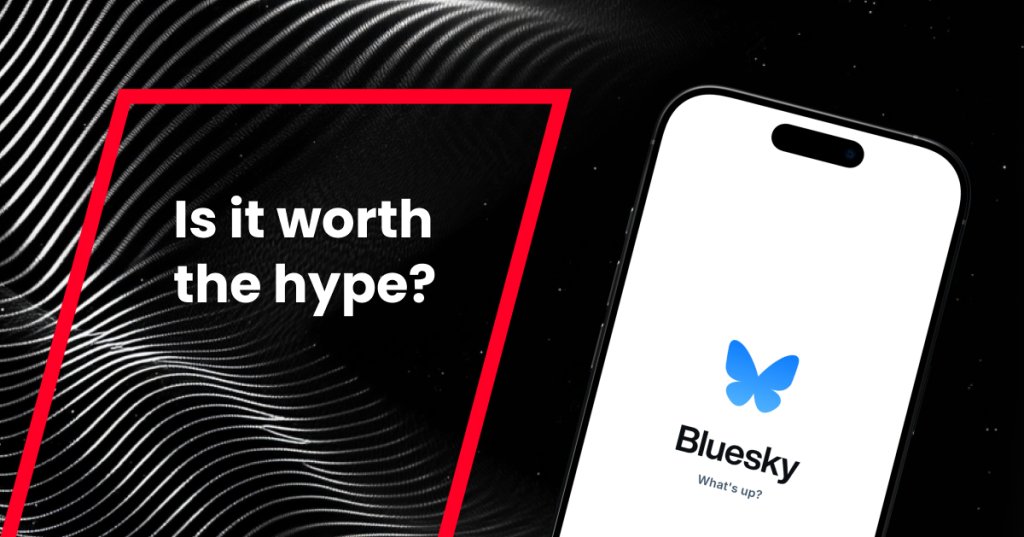BlueSky, the decentralised social network, initially gained traction from users eager to explore a new, more privacy-focused platform. After an early surge in registrations, user growth plateaued, leading some to question its long-term viability.
Despite a temporary uptick in registrations post the 2024 US elections, the challenge remains: can BlueSky maintain this growth and keep users engaged? Should advertisers be investing in this emerging platform? Is it worth the hype?
Let’s talk about it.
Navigating social growth and engagement
The question of sustained user engagement for BlueSky is crucial. On the positive side, the platform’s decentralised nature is inherently appealing to users dissatisfied with networks like Twitter or Facebook, particularly in terms of privacy and data control.
BlueSky has built a loyal community of users who value these principles, and its open-source foundation gives it the flexibility to adapt and grow in ways that traditional platforms may struggle to do. If the platform continues to innovate and provide value through its unique features - such as allowing users to customise their experience or even create their own networks - there’s potential for long-term engagement.
However, the reality of maintaining user growth and engagement is more challenging. As of December 2024, BlueSky reported over 25 million users, with only 3.2 million active users, highlighting the platform's need to convert registrations into regular engagement.
While the political climate and dissatisfaction with mainstream social networks have spurred a brief uptick in interest, platforms like BlueSky often struggle to retain users once the novelty wears off. Early enthusiasm can lead to a “bounce” in registrations, but active, sustained engagement is harder to achieve. If BlueSky doesn't continue delivering fresh content and a rewarding experience for people, it risks a loss in user retention.
An ad-free social network
Early involvement on BlueSky could give brands a competitive edge by fostering organic engagement before the platform matures. However, there are limitations to consider.
Unlike mainstream social networks, BlueSky has explicitly rejected traditional ad models, opting instead for user subscriptions as a primary revenue stream. CEO, Jay Graber, has reiterated the platform’s commitment to an ad-free experience, meaning brands cannot rely on conventional paid advertising to reach audiences.
This presents both challenges and opportunities for marketers. BlueSky’s decentralised structure and emphasis on user control could allow brands to engage audiences through authentic, community-driven interactions, such as partnerships or influencer collaborations. However, without a formal advertising infrastructure, targeting audiences and scaling campaigns will require a more strategic, long-term approach.
Until BlueSky evolves its stance or introduces alternative monetisation tools for brands, advertisers will need to think beyond traditional digital marketing tactics to build meaningful engagement on the platform.
Is it worth the hype?
BlueSky holds promise, but much of its future remains uncertain. The network has certainly generated interest, but whether it’s truly worth the investment depends on your perspective.
For brands and marketers who are comfortable with risk and eager to pioneer new social media spaces, BlueSky presents an exciting opportunity. Its decentralised model could change the way we think about social media, giving brands the chance to position themselves as forward-thinking and socially responsible.
On the other hand, it’s important to be cautious about the sustainability of the hype. BlueSky is still in its infancy, and many of our newer platforms struggle to maintain long-term engagement and user growth. The rise of Threads, followed by a decline in active users, is a cautionary tale.
BlueSky could very well experience the same fate unless it continuously delivers new features and keeps users engaged in meaningful ways. While the platform has potential, it’s too early to say whether the hype will translate into lasting success or whether it will be another flash in the pan.
Advertisers should be strategic about their involvement, balancing the allure of early adoption with the understanding that BlueSky is still unproven in terms of scalability and long-term user engagement. If BlueSky can maintain its user base and expand its advertising infrastructure, it could become a valuable player in the social media space. Until then, it may be wise to wait and see.
